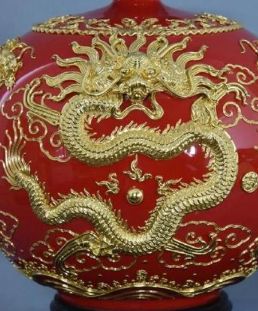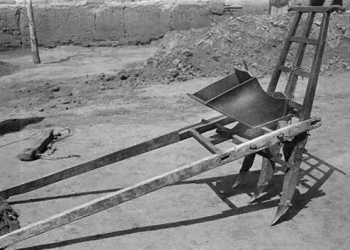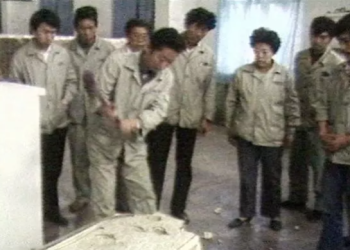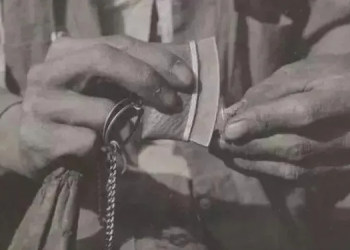Lines of varying thickness flow seamlessly, layered textures create a rich three-dimensional effect, and the vivid, resplendent colors captivate the eye—this is the visual artistry of Quanzhou Lacquer Thread Sculpture. Today, modern creations embrace a wide range of global themes, demonstrating both mastery and creative freedom that continue to astonish admirers.
An Art Form Rooted in Buddhist Sculpture
Since the flourishing of colored sculpture during the Tang Dynasty, lacquer thread techniques have been applied to Buddhist statuary. As early as several centuries ago, lacquer thread sculptures from Quanzhou gained renown both domestically and internationally, with exports reaching countries across Southeast Asia. This craft involves intricately winding fine lacquer threads—crafted through a specialized process—into opulent depictions of figures and animals, often drawing on traditional Chinese motifs such as dragons, phoenixes, qilins, flowing clouds, and entwined lotus patterns.
Evolving from the art of decorating Buddhist sculptures, Quanzhou lacquer thread carving flourished in southern Fujian, closely tied to the prosperity of folk religions and temple statuary industries. During the late Ming and early Qing dynasties, artisans in Quanzhou began using lacquer thread techniques to decorate temple sculptures and divine effigies. Early methods were still primitive, employing simple materials such as glutinous rice paste and wooden molds, resulting in works prone to deterioration, insect damage, and deformation.
Later, craftsmen discovered that blending red brick powder with lacquer sap to create a kind of lacquer clay—then sculpted onto wooden frames—significantly extended the durability of their works, often lasting several years or even decades. From then on, lacquer thread sculpture emerged as a distinctive handicraft and entered the broader market.
Through ongoing experimentation and refinement by folk artists, the art matured into a highly sophisticated form, widely cherished for its beauty. In early times, due to its scarcity and elegance, lacquer thread sculpture was primarily found in the homes of wealthy elites and large temples in southern Fujian, symbolizing wealth and social status. However, because of its complicated process and reliance on secret techniques passed down informally, the craft was nearly lost by the late 20th century.
Thanks to collective efforts, Quanzhou lacquer thread sculpture experienced a revival in the 1980s, ushering in a new era marked by its unique artistic identity. It became a popular choice for premium cultural gifts. In 2011, the craft was officially inscribed on the list of Fujian Province’s Intangible Cultural Heritage, securing its place in China’s cultural legacy.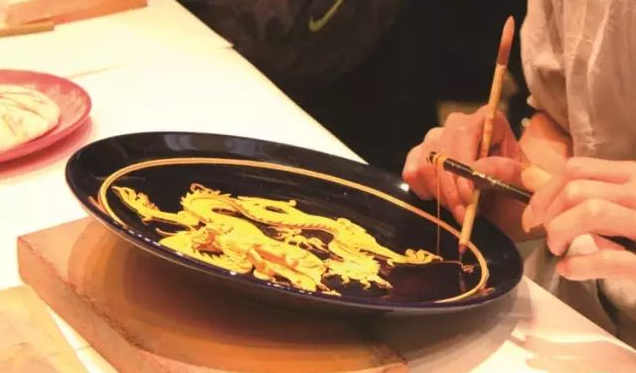
Quanzhou Lacquer Thread Sculpture: A Thousand-Year-Old Folk Art Form
Lacquer thread sculpture, a unique and time-honored Han Chinese folk craft, has been flourishing in Quanzhou for over a thousand years. Today, modern lacquer thread sculptures in Quanzhou are crafted using natural lacquer mixed with lacquer sap, hand-rolled into threads as fine as silk or as thick as a pen shaft. Through a complex series of over ten meticulous steps—including layering, carving, engraving, winding, coiling, and wrapping—each artwork is shaped and air-dried naturally before being finished with gold leaf. The final products are known for their smooth lines, exquisite details, and refined craftsmanship.
When speaking of the history of Quanzhou lacquer thread sculpture, one cannot overlook the ancient Buddha statue housed in the Zhenbao Hall of Xiandong Mountain in Penghu, Yongchun. According to local legend, the statue was enshrined by Chen Jingtai, son of the last emperor of the Southern Chen dynasty, who fled to Yongchun at the end of the Sui dynasty. Elders at the temple recount that the central figure, Vairocana Buddha—revered as the supreme deity in Esoteric Buddhism—dates back to the Sui dynasty, suggesting that this craft has a history of more than 1,400 years.
According to Lü Jinjie, an 83-year-old Buddhist layman and secretary of the Yongchun Buddhist Association, although the statue does not bear an explicit date, its historical significance is well-acknowledged. Lü affirms that the Buddha was originally housed in a small temple on Xiandong Mountain before being moved to its current location in the Zhenbao Hall. This lends preliminary evidence that lacquer thread sculpture was practiced in Quanzhou as early as the Sui dynasty.
In Yongchun—known as China’s “Incense Capital”—the Lü family has passed down the lacquer thread technique for sixteen generations. Lü Junjie, a 52-year-old craftsman and the 24th-generation descendant of the Lü family, represents the 15th generation in the lineage of lacquer thread artists. His son marks the 16th. According to the Lü family genealogy, their ancestor migrated from Weishui in Henan Province during the Yuan dynasty, and it was the ninth-generation heir Lü Tianfu who first began practicing lacquer thread sculpture. Traditionally, the art was passed from father to son, but with the progress of modern society, the craft has spread widely beyond the family and into the broader community.
Since the 1980s, lacquer thread workshops and production bases have grown rapidly across Quanzhou’s 11 counties and districts. In Zhangban Town (now part of the Quanzhou Taiwan Investment Zone) alone, there are over 80 lacquer thread factories and workshops. Most practitioners of this art in Fujian, Taiwan, and throughout Southeast Asia are of Quanzhou origin. Unsurprisingly, the majority of lacquer thread products on the market today are also made in Quanzhou, solidifying its status as the heartland of this remarkable folk tradition.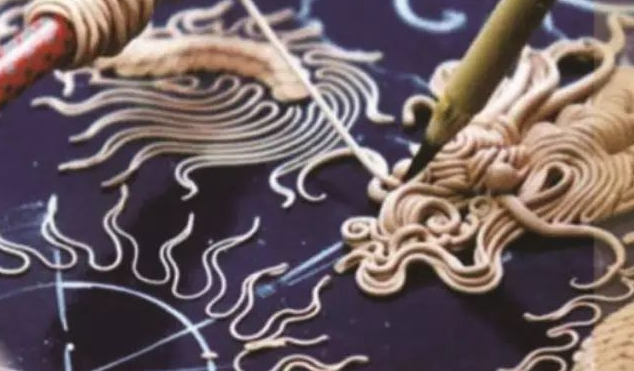
Quanzhou Lacquer Thread Sculpture: Reviving a Thousand-Year Craft in the Modern Era
While the lacquer thread sculpture industry in Quanzhou is primarily concentrated in Zhangban Town of the Taiwan Investment Zone, skilled artisans are spread across the region. Districts like Licheng, Fengze, Luojiang, Quangang, Jinjiang, Shishi, Nan’an, Hui’an, Yongchun, and Dehua all boast talented craftsmen dedicated to this ancient art. As society evolves, modern Quanzhou lacquer thread sculptures continue to draw from a wide range of artistic traditions—embellished with gilded and silver finishes, they are visually stunning and highly valued for both appreciation and collection. This remarkable art form stands as a brilliant fusion of traditional Chinese culture and contemporary creativity.
According to Huang Xueyu, a provincial-level representative inheritor of the Quanzhou Lacquer Thread Sculpture—recognized as an Intangible Cultural Heritage project—the creation of a lacquer thread sculpture involves four primary stages: shaping, base layering, thread application, and gilding with coloration. Entirely handcrafted, the process is intricate and time-consuming. The technique of expressing patterns purely through lacquer threads is unique to this art form in all of China.
Historically, lacquer thread sculptures were limited to lacquered baskets and theatrical props. In recent years, however, the craft has expanded to decorate porcelain plates, vases, incense burners, and glassware, enriching the product range and inspiring continuous innovation. Over centuries of refinement, Quanzhou’s lacquer thread art has not only inherited the traditions of Buddhist sculpture but has also integrated techniques from other artistic disciplines, leading to a more diverse and enriched style.
However, the craft industry faces fierce competition. In nearby Xiamen, lacquer thread brands like Cai’s Lacquer Thread Art and UBD Lacquer Craft have emerged as industry leaders—shining examples of brand-building and commercial success. For Quanzhou lacquer thread sculpture, the pressing challenge lies in achieving a similar breakthrough—transforming this traditional craft into a modern, culturally resonant brand.
A ceramic expert from Dehua noted that integrating lacquer thread art with Dehua porcelain yields pieces of extraordinary cultural and artistic value—a perfect example of merging traditional craftsmanship with modern aesthetics. Looking ahead, the industry must pursue greater technical precision and scientific process management. Innovation in technology should fuel innovation in artistry.
Industry experts agree: as times progress and people’s cultural and aesthetic sensibilities evolve, the content, style, and technical execution of lacquer thread sculpture must also advance. In today’s world, dominated by mass-produced goods, handcrafted arts that embrace a modern spirit have become increasingly precious. Lacquer thread sculpture, in this context, holds vast potential for growth and global appreciation.
